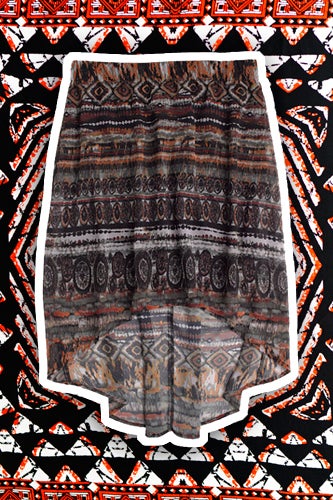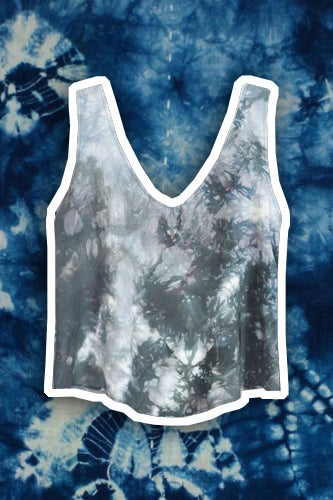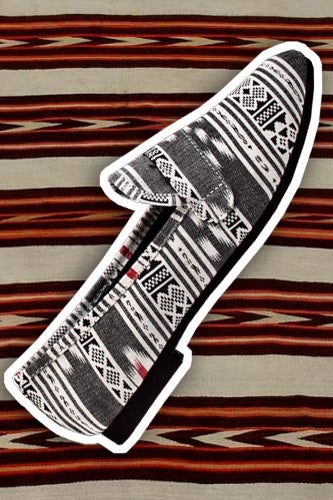You’ve seen them crowding the racks at stores and draping the bodies of some of the most well-dressed ladies around… but, what do you actually callthem? You know what you shouldn’t call them: the hyper-general African print, the offensive “tribal” print, the catch-all “ethnic” print…not okay.Lumping all similar prints into one group or referring to them by a descriptor rather than their real names is just as silly as calling jeans “blue pants,” or a Le Smoking a “black suit.” So, we’re here to provide a little vocabulary lesson. From ubiquitous Dutch Wax prints to the traditional, striated Ganado print, we’ve got the real names and stories behind these historic prints. Read on and banish the term “ethnic print” from your lexicon, once and for all.

Ikat Print — Creating an ikat print is a complicated process that involves binding the threads, piecemeal dying, and weaving everything together after the threads have been dyed. Because of this, ikat fabrics are instantly recognizable by their up-and-down, almost bleeding-dye quality. This process has been practiced all over the world, from Mexico to Uzbekistan and Cambodia to Japan.
Photo: Courtesy of Mood Fabrics/Photographed by Guang Xu; Joe’s Ikat Crops, $179, available atAnthropologie.

Ganado Pattern — According to Navajo art expert Jeff Wood, of Indian Territory Gallery, when rug weaving techniques were introduced to the Navajo (or Dineh) in the late 1800s, they started weaving a few particularly popular designs to trade — these incorporated many now-familiar design elements including diamonds, crosses, and bands. The “Ganado” design typically used deep red vegetal dyes to create a borderless, geometric rug. Most tessellating, serrated, “woven”-style prints in deep, natural hues were most likely inspired by these Ganado designs!
Photo: Courtesy of Indian Territroy; Freebird by Steven Caballero Low Boot, $320, available atLori’s.

Dutch Wax Print — The history of dutch wax is an international one, with the Dutch adopting Indonesian wax-resist dyeing (batik prints, anyone?), and bringing the technique to West Africa in the 19th century. Says Edward DeCarbo, professor at Pratt, “These fabrics are ubiquitous in African markets and in African daily life. Usually sold in lengths sufficient to make a blouse and/or a head cloth, patterns are selected and garments [are] tailored for the stylish individual, and expresses the significance of an event or situation by wearing a [specific] textile pattern.” Known for its splashy, super-bright colors and oversized patterns, Dutch Wax cloth is used to create traditional garments called kitenges, which are worn by women in Eastern and Southern Africa.
Photo: Courtesy of Vlisco; Topshop Animal Africa Print Backpack, $56, available at Topshop.

Tapa Print — Native to the Pacific Islands, tapa cloth is made from bark and is painted, stenciled, stamped, smoked, and dyed to create abstract animal designs, geometric shapes, and patterns. Usually distinguished for its red, black, and tan colors and tropical motifs, it’s a cloth that was traditionally given as gifts and worn on formal occasions in many Pacific islands.
Photo: Courtesy of Mood Fabrics/Photographed by Guang Xu; Delia’s Ethnic High-Low Skirt, $39.50, available at Delia’s.

Shibori Print — A Japanese-developed process of tie-dying, shibori involves folding, twisting, and manipulating cloth into lovely, organic patterns. Typically done with blue dye, there are a few distinctive styles of shibori, including concentric circles, striated lines, and scales. Don’t call it child’s play either — master shibori artists can create some ridiculously elaborate patterns that’d make your camp T-shirts look like… well, camp T-shirts.
Photo: Courtesy of RugRabbit; UpstateReversible Tank, $96, available at Bona Drag.

Aloha Print — To appeal to a wider range of customers during the Great Depression, Honolulu resident Ellery Chun began selling short-sleeved shirts made of leftover Japanese kimono fabric, which included designs with palm fronds, hula girls, and pineapples. The “Aloha” shirt has since evolved into all manners of clothing, and became a staple of Hawaiian fashion.
Photo: Courtesy of Mood Fabrics/Photographed by Guang Xu; Lulu & Co Tropical Printed Shorts, $324.35, available at Glassworks.

Batik Print — Using drawn-on wax, batik prints are a dying technique that’s super popular all over Southeast Asia, parts of the Middle East, and Africa, but the Javanese batik print is the one that’s come to currently be the most inspirational in fashion today. Bolder, more complicated patterns are usually worn by nobility while simpler designs are for everyday use — ranging from florals and paisleys to geometric shapes, batiks can come in thousands of styles, but all have that tell-tale delicately layered look.
Photo: Courtesy of MartijnL; A.P.C. Skirt, $261, available at Coggles.

Chinle Pattern — With wide bands of alternating shapes and stripes, the Navajo-designed Chinle pattern came to form in the ’20s. These rugs with long strips saw a surge in home decor popularity during the ’30s, and are coming back in a strong way on tons of fashion accessories and textiles, at present. Though the proliferation and general enthusiasm for Navajo aesthetics are awesome, says Jeff, “The most direct benefit [happens] when that appreciation translates to the purchase of original rugs, jewelry, and the artworks as this allows the Navajo tradition to continue.” Word!
Photo: Courtesy of Indian Territory; Steve Madden Eltonn Shoe, $59.99, available at Heels.
Click HERE to read more from Refinery29.

Be the first to comment